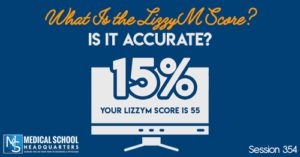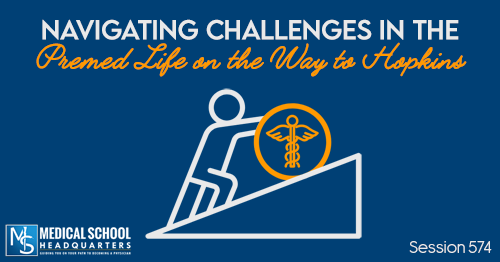Apple Podcasts | Google Podcasts

Session 354
LizzyM is just an equation. How do you fit your history, experiences, struggles, triumphs, and trends into that equation? Spoiler: You can’t.
Remember, your application is so much more than your MCAT or GPA scores. Yes, they’re important. But your story matters more than just a math equation.
For more resources, be sure to check out Meded Media to help you along your path towards becoming a medical student, and hopefully one day, a physician.
Listen to this podcast episode with the player above, or keep reading for the highlights and takeaway points.
[01:00] Who is LizzyM?
It’s said to have started off as an SDN anonymous account. It was seemingly an admissions committee member at a pretty well-known midwestern medical school. Then that account transitioned into a group of admissions committee members coming from different medical schools.
LizzyM does provide a lot of great advice on SDN (Student Doctor Network). It’s also known for having this LizzyM score, which is a math calculation.
Before the new scoring system of the MCAT changed, the LizzyM score would be derived from taking the GPA x 10 + pre-2015 MCAT score. So if you have a 3.5 GPA and MCAT score of 35, your LizzyM score is 70.
'Using the LizzyM score is just one small piece of data that is very limited in how it can function and how it can help you with applying to medical school.'Click To TweetA lot of students look at the LizzyM score thinking it’s some magical equation to tell them how competitive they are in applying to specific medical schools. This could be how some schools could be sorting people out. But the score is such a small piece of data that is very limited in terms of applying to medical school.
Applying to medical school is not as binary as plugging in your GPA, MCAT score, gender, race, etc, into some equation to find out where you should go to medical school. If that were the case then every student who scored the same who would be applying to the same schools would have been getting interviews and accepted.
'Applying to medical school isn't a binary act. There are so many intricacies, nuances, and complexities in the medical school application process.'Click To TweetYou cannot rely on an algorithm or a mathematical equation that takes your GPA and MCAT to figure out where you should be applying to medical school.
[06:45] Schools Look at Trends
'GPA and MCAT are very important because schools have cut-offs. But you shouldn't be applying to medical schools based on GPA and MCAT.'Click To TweetYou have to have a good enough GPA and MCAT scores to pass those filters. But here’s the problem with just looking at GPA and MCAT score.
You may be doing poorly through your first degree or just your first semester and you stopped going to school. You may have a very bad trend in your GPA. Then you look at the ability to raise your GPA based on how many credits you need to graduate or get a second degree or just to take your prereqs.
However, you may only be looking at an overall 3.2 GPA, when in fact, your trend was amazing towards the end. Then you plug in your GPA score into the LizzyM calculator and you got a 511 on the MCAT. But if you “only” have a 3.2 since LizzyM can’t take trends into account, your LizzyM score is going to be 63. Then you look at the data LizzyM provides and it shows all the scores for medical schools.
Different schools have different ways to view your application. There are many schools that look at your trend. Some schools only look at your last 32 hours or at your last 20 hours of science credit. That’s how they determine your caliber of academic success. And they won’t see a 3.2. They will potentially see a 4.0.
[Related tool: Med School GPA Calculator for AMCAS, AACOMAS, and TMDSAS]
[10:50] Looking at the Historical Data from AAMC
Medical schools are not going to SDN and base their screening on the LizzyM score. Rather, SDN is looking at the data available through AAMC or whatever data they’re reaching out and getting from schools.
'Remember, historical data only tells you the GPA and MCAT scores of the students who were accepted. It's not telling you why they accepted those students.'Click To TweetObviously, their GPA and MCAT had to be high enough to pass whatever filters that the school has set in place.
I have the luxury of talking to a lot of deans of admissions and other admissions committee members. They share things with me and I get to share that with you. One of them shared that the board or people above the admissions committee set their median MCAT requirement at 520.
It’s ridiculous to have some arbitrary number of success set by some random group of people. They want to be prestigious and they only want students who are going to come together so that their stats make it look like they have the smartest students. But your score on the MCAT only proves that you can take the MCAT really well. That’s all.
Does the MCAT really prove how smart you are? Does the MCAT prove that you’re going to be an amazing physician?
I had a student who struggled with the MCAT and took a break. He restudied and crushed it going from a 506 to 520. I asked him how he did it and he said that he studied the MCAT. He didn’t study for the MCAT, he studied the MCAT. He learned how they were writing the questions and the answer choices. He figured out what they wanted him to do for each question. He was actually able to reverse-engineer the MCAT.
All the MCAT is doing is proving that you can do really well on the MCAT. And some schools use it to prove that they’re the best school.
Again, the schools aren’t saying what their LizzyM score is and it’s what you need to get in. Instead, they’re showing what their class looks like last year. It’s also an aggregate number so it’s not looking at individuals.
[Related episode: Changes the MCAT AAMC Practice Material and Registration]
[15:55] Your Story Matters
In a lot of medical schools that filter applications, they’re actually sorting those applications and all those that don’t pass the filter don’t immediately go to trash. Some schools just place them in a different basket. They’re going to assign someone to go through those applications and look for the diamonds in the rough.
'There are some schools that want the stats, but your story matters... the LizzyM score will not capture your story. It cannot capture your trends.'Click To TweetYour story matters and you have to realize that. What doesn’t capture a story is a silly math equation called the LizzyM score. It can’t capture your trends or your story.
It can’t capture that you are homeless and had to overcome moving 20 times with your family because you kept getting evicted. It can’t capture that you came to the country at 14 years old and had to learn English for the first time.
No grading system can capture all those things. So when you look at the AAMC data and see a 4.0 student with a 520 MCAT score, and you see that only 85% of students are accepted. How did they not get accepted? Their story probably didn’t resonate with the admissions committee member.
[Related episode: Your Amazing Premed Stories!]
[19:15] Apply Broadly
Students may think that because they have a high LizzyM score, they’re only going to apply to the top institution.
'No matter who you are, applying to the most competitive schools because you have super competitive stats is not a good idea.'Click To TweetWhen applying to medical schools, you need to apply broadly. Don’t apply based on the MCAT and GPA. Don’t go to the MSAR. Don’t go to SDN and look at your LizzyM score. Don’t plug your scores into the MSAR and create your school list from that.
Based on the AAMC data, students now apply to an average of 16 schools. This is up from the previous average number of 14. Over 50,000 students apply to medical school and if you multiplied that by 2 as every student now is applying to 2 more schools. That’s an extra 100,000 applications going to medical schools.
Each of those applications costs money and the AAMC is getting that money. It’s in the best of interest of AAMC to have students apply to more and more schools. And this is the possible reason they’re not giving as much data because this may limit the number of schools that students apply to.
'As students apply to more and more schools, that's more money for the system, at the detriment of the students.'Click To TweetMoreover, students are going into more and more debt while more money goes into the system as they apply to more and more schools.
[22:03] Are You a Good Fit?
As you’re looking at medical schools to apply to, don’t just apply to amazing schools just because you have amazing stats.
“Your story and your fit matter so much more.”Click To TweetDr. Sunny Nakae was here back in Episode 342. She’s from the University of California Riverside. Students who are based in San Francisco look at their 4.0 GPA and 520 MCAT score and 77 LizzyM score.
The LizzyM score for UC Riverside is much lower than that so it’s a safety school. But their mission is to serve the students who are going to serve the Inland Empire.
Therefore, look at the school and their mission before even applying to figure out where you’re going to be a good fit and not just based on MCAT and GPA.
You have to do your research when applying to medical schools. Look at their mission and vision statements. Look them up on YouTube, Twitter, Instagram, etc. and look at what students are saying about the schools.
Stay tuned for Med School Reviews soon where we’ll have students rating the schools and leaving comments about the schools. We will also verify that they are students at the schools.
'You have to know about the school more than just what their MCAT and GPA are because you are much more than that.'Click To Tweet[25:30] WARS vs LizzyM
WARS (WedgeDawg Applicant Rating System) was created a couple of years after the LizzyM was created by another SDN user named WedgeDawg.
When you look at the post to support their algorithm, they would have the applicant rank on their own scale. They categorize the medical schools and you can see how many applications each medical school gets and how many students they accept. But all this data doesn’t really mean anything.
And you can’t just say one school is much more selective than another school just by looking at those numbers.
State schools don’t accept a lot of students from out of state. But the University of Kentucky, for instance, is a pretty rural state which means there’s not a lot of premed students in the state. Hence, there’s not a lot of applicants. So they don’t have to be as selective because they have more seats and fewer applications. It doesn’t mean it’s a less prestigious school. They’re just more open with who they’re accepting.
So if you look at this just based on the numbers, it may seem easier to get into University of Kentucky than it is to Washington University. But you can’t extrapolate that information.
WARS is based on selectivity but you can’t extrapolate any information from that. It’s just simple math – total number of applications, the number of seats, and that’s how selective they are.
WARS involves plugging in subjective information and then you base which schools you’re going to apply to on their score. Again, you’re leaving your story out of it.
'None of these that claim to help you create a school list will help you create a school list.'Click To Tweet[31:15] How Schools Are Reviewing Applications
You still have the chance of going to a great medical school, whether MD or DO.
'Every school has a different process. Even without perfect stats, you still have a chance of being a physician.'Click To TweetRubrics are a very common way that medical schools review applications. They can create a rubric that will score applications based on all the other parts of the application and not just MCAT and GPA.
Based on that very objective rubric, they will get very standard scores. This is a way to remove subjectivity out of the rating system for applications.
For instance, an application gets some corresponding number of points for different aspects such as GPA range, MCAT score range, clinical experience, disadvantaged statement, extracurriculars, research, volunteering, personal statements, etc.
Then those applications that get the highest points based on their rubric are invited for an interview first. Then they go down their list until all interview spots have been filled up. This is how a lot of medical schools are reviewing applications.
Other medical schools don’t have a rubric and they just have reviewers review the applications. That’s okay as every medical school is going to be different. A
'Your story, your extracurriculars, what you've done and what you've had to overcome paint a much better picture of who you're going to be as a classmate, a physician, and as an alumnus.'Click To TweetUltimately, any piece of mathematical equation or data based on your scores don’t tell you anything about how a school is reviewing applications. Your story matters!
[Related episode: How To Thoroughly Review Your Own Med School Application]
Links:
PMY 342 with Dr. Sunny Nakae: Discussing the Application Cycle with an Admissions Expert











